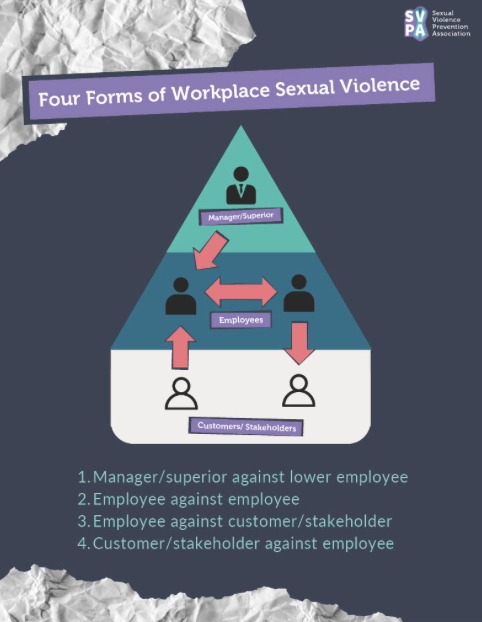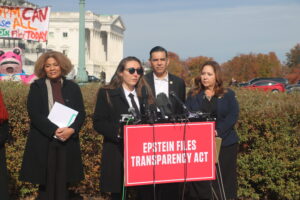Workplace sexual harassment is more common than many realize, yet it often remains hidden in silence. Studies show that 38% of women and 14% of men have experienced sexual harassment at work, but over 85% of incidents go unreported. Even worse, 60% of women report facing unwanted sexual attention, coercion, or degrading conduct in the workplace.
The toll is not just personal; the ripple effects damage workplace morale, decrease productivity, and even cost businesses billions annually.
Workplace sexual violence doesn’t discriminate. Its impact cuts across industries, affecting everyone from office professionals to workers in sectors like garment manufacturing, rideshare services, and hospitality.
Workplace sexual violence, as defined by the SVPA, encompasses all forms of sexual assault and harassment that take place between managers, employees, customers, clients, or stakeholders who are affiliated with a company, agency, or employer. The SVPA workplace sexual violence framework categorizes workplace sexual violence into four main types. First, there’s misconduct by managers or superiors toward employees, such as using authority to demand sexual favors, also known as quid pro quo harassment. Second, it includes harassment between employees, ranging from unwelcome comments to more severe acts. Third, it highlights cases where employees abuse their relationships with clients or stakeholders, and lastly, it covers harassment or threats directed at employees by customers or stakeholders. The examples illustrate how workplace sexual violence can manifest in various scenarios, emphasizing the misuse of authority, influence, or control to harass or abuse others.

Real-world incidents illustrate the pervasive nature of workplace sexual violence. In 2024, the U.S. Equal Employment Opportunity Commission (EEOC) filed three lawsuits, including cases where victims were harassed and retaliated against for speaking up. At a Burger King franchise, supervisors harassed female employees while management ignored complaints. Sofidel America Corp. fired a woman after she sought legal protection from a harassing coworker. At Sunrooms and More Design Center, a company owner harassed employees daily and retaliated against those who reported it. Additionally, in fiscal year 2023, the EEOC received over 7,700 charges of workplace sexual harassment, marking a 12-year high and a nearly 25% increase from the previous year. These cases underscore the urgent need for companies to create safe and respectful workplaces.
Workplace sexual violence can manifest in both subtle and overt ways, making it critical to recognize the full range of behaviors. Subtle signs might include inappropriate jokes, unwanted compliments, or persistent advances that make someone uncomfortable. On the other hand, overt actions like sexual coercion, groping, or explicit threats leave no ambiguity about the harmful intent. Both types of behavior can have lasting consequences.
Victims and even bystanders may experience profound psychological and physical effects, such as PTSD, anxiety, depression, and a heightened sense of vulnerability. Professionally, careers can be derailed through reputational harm, missed opportunities, or outright retaliation. The garment industry, the rideshare industry, and service sectors are especially vulnerable due to power imbalances, lack of oversight, and frequent interaction with strangers. Understanding these signs is the first step toward creating an environment where misconduct is addressed head-on and victims feel supported.
If you have been affected by workplace sexual violence, understanding your rights and protections is essential. Federal laws like Title VII of the Civil Rights Act and the complaint processes established by the EEOC offer legal recourse. Additionally, many states have anti-harassment laws designed to protect employees. Nonetheless, victims often face barriers, such as fear of retaliation, stigma, or the drawn-out nature of legal processes. Overcoming these challenges requires support and courage, starting with knowing where to begin.
If you’ve experienced sexual violence or abuse, consider taking the following steps. Document the harassment or abuse, including emails, messages, and witness testimonies. Report the behavior to a trusted HR representative or manager. Seek legal aid through advocacy organizations like Select Justice or C.A. Goldberg PLLC, which can help connect you with lawyers and free case evaluations.
To proactively prevent sexual violence in the workplace, employees can use the SVPA Workplace Employee Guide. Managers, executives, and other workplace leaders can use the SVPA Workplace Leader Guide. All workplace personnel can use Select Justice’s resources on Employer Negligence to learn how to identify and take action against employer negligence.
Together, we can create workplaces where everyone feels safe, respected, and valued. No one deserves to face sexual violence at work, and by standing united, we can foster environments that prioritize dignity, equality, and accountability. Let’s commit to being part of the solution.






